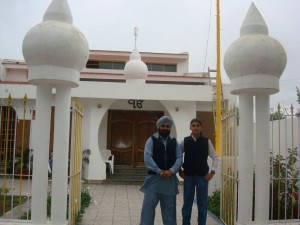
Argentina is a captivating land which is world renowned for its spectacular landscapes, football crowds, seductive tango, cowboys and most notably its distinct multicultural tapestry.
This Latin American nation is home to forty million people who hail from an intricate network of different ethnic communities and interestingly, the South Asians form a notable minority in this land of immigration. The ethnic backgrounds of Argentineans are so diverse and so has the nation earned its nick name ‘the crucible of races’.
The bygone Colonial era of Argentina opened the door ways for the settlement of Asians predominantly from China, Japan and Korea and since the 19th century, migrant workers from British India reached the shores of Argentina on the request of the British officials to work on plantations, mines and British built rail roads. The intermittent antecedents of migrant workers to Argentina have strengthened the Indian Community and as for today, they number closer to two thousand individuals. Based on the records and books penned by Colonial authors, many of these Indian migrant workers came from the territory of Punjab and from the Western frontiers of British India. The dry and modest town of Rosario de Frontera known by its local sobriquet ‘Punjab la aldea’ meaning Panjabi hamlet located on the mountainous terrains in the province of Salta in North Central Argentina is popular amongst locals and tourists as the home to Latin America’s only Sikh Gurdwara temple and this surely helps validate the unmistakable Panjabi factor in Argentina. History has it that during the 19th century the slave workers from India who were put to work on plantations and minefields in Guyana, Suriname, Peru, Chile and Brazil slipped inlands and walked their way to present day Argentina. Due to Punjab’s late incorporation into Colonial rules, few were deported to Guiana as indentured slaves so the majority of those who settled in the region of Guiana, hailed from the present day Indian provinces of Bihar, Uttar Pradesh, Himachal Pradesh, Rajasthan and Haryana.
Those who managed to escape from the clutches of the British and Dutch settled down as farmers and free slaves primarily in the Northern provinces of Salta or Jujuy in Argentina and some are believed to have espoused local women in the region and even adopted Catholic patronymics. For the anthropologists, linguists and ethnographers, the Northern territory of Argentina, is a haven where diverse mountain cultures can be discovered in every mountain pass and Pasteur as many of the locals in the region share some distinctive features of Indian physiognomy and some have even incorporated elements of Indian culture in the daily lives.
The Indian community in Argentina witnessed a gradual increase in number during the 1970’s, a period when many Indians embarked their journeys to Canada and the USA expecting a better quality of life. Those who were unfortunate and the ones who couldn’t make their destined journeys eventually ended up in Argentina and later made permanent settlements in the country. Argentina, the land of adoption has now become their home, and today they form a close-knit mercantile community and the Punjabis have reasonable control over the country’s trade monopoly. The streets of Rosario de Frontera, are dotted with Indian textile boutiques, restaurants and grocery shops that cater the needs of the locals and at present the Indians form an inseparable entity in this remote village. Many believe that the similar climate, and the close resemblance to Punjab’s topography, favoured the settlement of Punjabis in Rosario de Frontera since the early 70’s, and at present the village is home to three hundred Panjabi Sikh families. Nevertheless, the Colonial reminiscent Buenos Aires, Capital of Argentina also boasts of a significant Indian community, of whom many are physicians, Dental surgeons, economists, entrepreneurs, high profile businessmen and financial executives. Based on the latest reports, there are five hundred non residential Indians who have domiciled in Argentina yet they have retained their Indian citizenship despite their years of stay in Latin America and they continue to enjoy the status of a NRI.






















